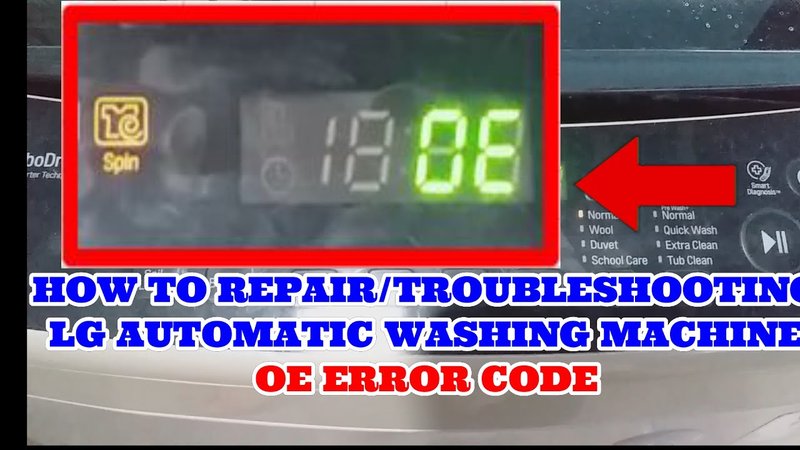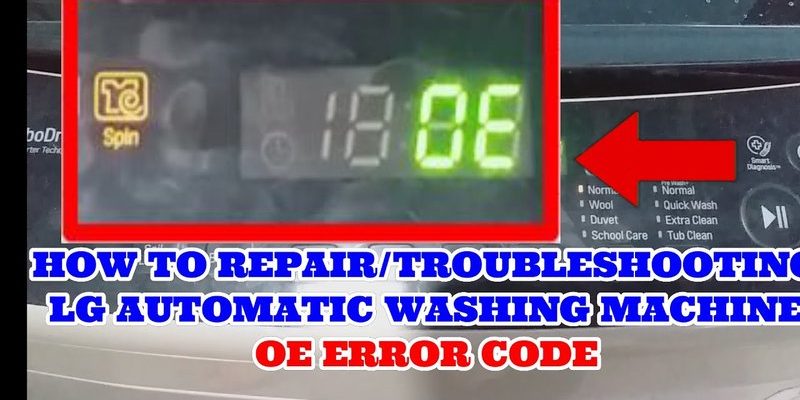
Now, let’s unravel this. The “OE” error code essentially indicates a problem with the drainage of your washing machine. Think of it like your bathtub refusing to empty after a long soak—frustrating and a bit concerning. While this can be a minor issue, there are times when you need to call in the experts. In the upcoming sections, we’ll explore when to handle things yourself and when it’s time to call a technician.
Understanding the OE Error Code
Firstly, let’s break down what the OE code actually means. In the universe of LG washing machines, “OE” is a shorthand for “Outlet Error.” This usually points to a drainage problem, where water isn’t being expelled from the machine as designed. Imagine trying to empty a kiddie pool through a straw; it just doesn’t work. Similarly, your washing machine needs clear pathways to drain efficiently.
Typically, the error could stem from something as simple as a clogged drain hose or a kink in the hose itself. Think of it like a garden hose that’s been pinched—water can’t flow out smoothly if there’s an obstruction. However, if these straightforward solutions don’t resolve the issue, it might hint at a deeper problem, like a faulty pump or something more complex inside the machine.
It’s vital to grasp the groundwork of this error because, while it’s common, it varies in severity. Recognizing the signs early on can save you from potential headaches and costly repairs down the line. If you start to notice water not draining as it should or hear unusual gurgling sounds, it’s time to take a closer peek at what’s happening with your machine.
DIY Troubleshooting Steps
Before dialing up a technician, there are a few simple steps you can try at home. Start by checking the drain hose. Is it kinked or clogged? Sometimes small items like socks or a buildup of lint can cause a blockage. Just like how a blocked sink needs plunging, a good inspection might clear the path and solve the problem. Gently straighten any kinks and ensure that the hose is placed correctly.
Next, you might want to inspect the drain pump filter. Think of this as a lint trap for your washer. If it becomes clogged, water can’t exit, leading to that infamous OE error. You can usually access the filter at the front bottom of your machine. Carefully open it—keeping a towel handy to catch any water—and clear out any debris. This step alone can often resolve drainage issues.
However, if after these efforts the error persists, don’t fret. It might mean the problem is complex enough to warrant professional intervention. Attempting more advanced fixes without expertise can sometimes worsen the issue or even void your warranty. So, at this point, it’s wise to consider calling for professional help.
When to Call a Technician
Here’s the deal: if you’ve done your due diligence with the basic troubleshooting steps and the OE error still looms, it’s time to bring in a technician. Why? Because certain issues, like a malfunctioning drain pump motor or electrical faults, require a trained eye and the right tools. Think about it like trying to repair a car engine without being a mechanic—some things are best left to the pros.
Calling a technician not only ensures the issue is diagnosed correctly, but it can also prevent small problems from escalating into major repairs. They can dig into the nitty-gritty details, checking components like the water level sensor or control board that could be contributing to the OE error.
Moreover, technicians can offer insights into preventing future drainage problems. Regular maintenance tips, like routinely cleaning the pump filter and ensuring hoses are clear, can be part of their repertoire. Prevention is always better than cure, especially when it comes to complex appliances like washing machines.
Simple Tips for Maintenance and Prevention
To avoid this pesky OE error in the future, there are a few proactive steps you can take. Regular maintenance is your washing machine’s best friend. Imagine it like visiting the dentist regularly to avoid cavities—consistent care goes a long way.
Start by ensuring you don’t overload your washer. Overloading can strain the machine and exacerbate drainage issues. Also, make it a habit to clean the drain filter every month or so, especially if you use your machine frequently. This small act can prevent larger blockages and keep water flowing as it should.
Finally, keep an eye (and ear) on your machine’s performance. Unusual noises or changes in how water drains can be early indicators of a problem. Catching these signs early means you can tackle them before they snowball into a full-fledged error code situation. And remember, if ever in doubt, consulting a professional is always a safe bet.
In conclusion, understanding when to call a technician for your LG washing machine’s OE error code is a balance of knowing what you can handle and recognizing when expert help is needed. With a bit of preventive care and timely intervention, your laundry days can be smooth and hassle-free.
